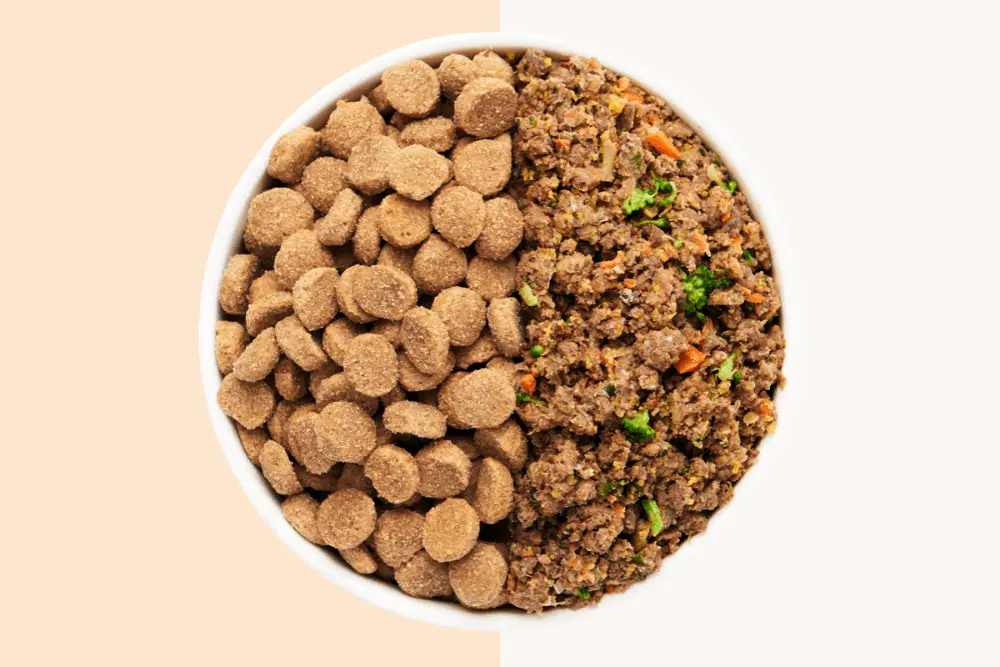Mealtime is one of the most important parts of your dog’s day, but what if your furry friend has trouble chewing their kibble? Larger kibble pieces can be difficult for some dogs to manage, leading to discomfort and even digestive issues. Fortunately, making your dog’s kibble smaller is easier than you might think, and you can do it at home!
In this section, we’ll show you step-by-step how to make your dog’s kibble smaller, no matter the size or breed of your furry friend. You’ll learn about various methods, including using a dog food grinder or processor, moistening and crushing the kibble, and mixing small kibble with wet dog food.
Key Takeaways:
- Smaller kibble size can benefit dogs with smaller mouths, dental issues, or those who gulp their food.
- Assess your dog’s specific needs when it comes to kibble size.
- Using a dog food grinder or processor can be a game-changer for significantly reducing kibble size.
- Moistening and crushing kibble can also be an effective method, as can mixing small kibble with wet dog food.
- Consult with your veterinarian throughout the process if you have any concerns or questions.
Why Smaller Kibble Size Matters for Dogs
Have you ever noticed your furry friend struggling to chew their kibble or swallowing it whole? It’s a common issue for dogs, especially those with smaller mouths or dental issues. This is where smaller kibble size can make a huge difference.
Smaller kibble size promotes better chewing and digestion, which can lead to improved overall oral health for your pup. It also helps prevent choking or gagging, especially for dogs who tend to gulp their food.
Furthermore, smaller kibble pieces can benefit older dogs who may have difficulty eating larger pieces or those with health conditions that require a modified diet.
By adjusting your dog’s kibble size to better suit their individual needs, you can ensure they enjoy mealtime and receive the necessary nutrition to maintain their health and well-being.
Benefits of Smaller Kibble for Dogs
When it comes to choosing the right kibble size for your dog, smaller is often better. Smaller kibble is easier for your dog to eat and digest, and it can also help to prevent weight gain.
There are a few reasons why smaller kibble is easier for your dog to eat. First of all, it takes up less space in your dog’s mouth, so they can eat it more easily. It also breaks down more quickly in their mouth, so they can start digesting it right away. And because it’s smaller, it’s also less likely to cause choking.
Smaller kibble is also easier for your dog’s digestive system to handle. It’s broken down more quickly and easily, so there’s less chance of it causing an upset stomach or digestive problems. And because it’s more quickly digested, it can help to prevent weight gain.
If you’re thinking about switching to smaller kibble, talk to your vet first to make sure it’s the right decision for your dog. There are a few different types of smaller kibble available, so they can help you choose the right one for your dog’s needs.
What You Will Need to Make Smaller Kibble
One of the great things about homemade dog food is that you can control the size of the kibble. This can be especially helpful if you have a small dog or a dog with a delicate stomach. If you’re wondering how to make smaller kibble, the process is actually quite simple. Here’s what you’ll need:
- A food processor or grinder
- A baking sheet
- Parchment paper
- A measuring cup
- A funnel (optional)
The first step is to grinding the ingredients. If you’re using a food processor, you’ll want to pulse the ingredients until they’re broken down, but not completely pulverized. If you’re using a grinder, you’ll want to grind the ingredients until they’re a fine powder.
Next, you’ll need to mix the ingredients together. If you’re using a food processor, you can do this right in the processor bowl. If you’re using a grinder, you’ll want to transfer the ground ingredients to a bowl and mix them together with your hands or a spoon.
Once the ingredients are mixed, it’s time to bake them. Preheat your oven to 350 degrees Fahrenheit. Line a baking sheet with parchment paper and sprinkle the parchment with a little bit of water. This will help to keep the kibble from sticking.
Using a measuring cup, scoop out 1/4 cup portions of the kibble mix and shape them into small discs. Place the discs on the prepared baking sheet and bake for 20 minutes. After 20 minutes, remove the kibble from the oven and let cool completely.
Once cooled, the kibble is ready to be served. If you like, you can use a funnel to fill up a dog food dispenser or storage container. And that’s it! You’ve now made smaller kibble that’s perfect for your little pup.
Tips for Easily Breaking up Large Kibble into Smaller Pieces
There are a few tips and tricks you can use to break up large kibble into smaller pieces. This can be useful if you have a dog that is on a diet or needs to limit their food intake, or if you simply want to make their food last a little longer.
One method is to use a food processor or blender. Simply pulse the kibble until it reaches the desired consistency. You may need to add a little water to get the blades moving, but be careful not to overdo it or you’ll end up with mush.
Another option is to put the kibble in a zip-top bag and use a rolling pin or other heavy object to roll over it and break it up. This might take a little longer than using a machine, but it’s still relatively quick and easy. And, it’s definitely less messy!
If you don’t have either a food processor or a blender, or you just don’t want to use them, you can always just do it by hand. This will take a little more time and effort, but it’s still doable. Just use a sharp knife to chop the kibble into smaller pieces. Start with larger pieces and then work your way down to smaller ones until you reach the desired size.
Whatever method you choose, breaking up large kibble into smaller pieces is definitely doable. And, it can be helpful in a variety of situations. So, next time you’re faced with a big bag of kibble, don’t be discouraged. Just break it down into smaller pieces and enjoy!
Considerations When Making Your Own Dog Food
There are a lot of things to consider when making your own dog food. The first thing you need to do is figure out what kind of food your dog needs. Dogs need a lot of protein, so you’ll need to make sure you’re including plenty of meat in their diet. You’ll also need to include some healthy fats and carbohydrates. Once you’ve figured out what your dog needs, you’ll need to find the right ingredients.
The next thing you need to consider is how you’re going to cook the food. You’ll need to make sure the food is cooked properly in order to ensure your dog is getting all the nutrients they need. You’ll also need to make sure the food is appetizing enough that your dog will actually want to eat it!
Once you’ve figured out all of that, you’ll need to start putting together your recipes. There are a lot of great recipes out there for homemade dog food, so you shouldn’t have any trouble finding something that your dog will love. Just make sure you’re including all the necessary ingredients, and cooking the food properly.
If you’re still not sure how to get started, there are a lot of great resources out there that can help. There are plenty of books and websites that can give you all the information you need to make your own dog food. Just make sure you do your research and find a recipe that’s right for your dog. With a little planning and some trial and error, you should be able to make your own delicious and nutritious dog food at home!
Alternatives to Making Smaller Kibble
As a pet owner, you may be wondering if there are any alternatives to making smaller kibble for your furry friend. Smaller kibble is often easier for small dogs or puppies to eat, and it can also help prevent them from overeating.
One alternative to making smaller kibble is to cut the kibble into smaller pieces. This can be done with a sharp knife or even a food processor. If you use a food processor, you’ll want to Pulse the kibble until it’s the desired size.
Another alternative is to purchase kibble that’s already been pre-cut into smaller pieces. This can be found at most pet stores or online.
If you have a large dog, you may be able to find kibble that’s designed for large breeds. This type of kibble is typically bigger in size and may not be suitable for smaller dogs.
Whatever route you decide to go, be sure to talk to your veterinarian first to ensure that you’re giving your pet the proper nutrition.
Conclusion
By following the easy guide provided in this article, you now know how to make your dog’s kibble smaller at home. Remember, smaller kibble size is essential for dogs with smaller mouths, dental issues, or those who gulp their food. It promotes better chewing, digestion, and overall oral health.
Assess your dog’s specific needs to determine the appropriate kibble size. If you need to reduce the kibble size significantly, using a dog food grinder or processor can be a game-changer. Alternatively, moistening and crushing the kibble or mixing it with wet dog food are other options to consider.
Always ensure that your dog’s nutritional needs are being met when making any changes to their diet. Consult with your veterinarian if you have any concerns or questions throughout the process. With these tips, you can create a more suitable kibble size for your furry friend, making mealtime more manageable and enjoyable for them.
Now that you know how to make dog kibble smaller at home, your furry companion will be able to enjoy their meals to the fullest. Happy feeding!
Frequently Asked Questions (FAQs)
Can I mix small kibble with wet dog food?
Yes, mixing small kibble with wet dog food is another option to make the kibble smaller. Find the right wet food for your dog and determine the proper ratio of kibble to wet food to maintain a balanced diet for your furry friend.
How can I moisten and crush the kibble to make it smaller?
Moistening the kibble and using various techniques, such as crushing it with a rolling pin or using a mortar and pestle, can help reduce the kibble size. Be sure to add just enough moisture to soften the kibble without making it soggy.
How do I assess my dog's kibble size needs?
To assess your dog’s kibble size needs, consider their breed, age, size, and any dental or health conditions. Consult with your veterinarian for guidance on the appropriate kibble size for your furry companion.
Why does smaller kibble size matter for dogs?
Smaller kibble size can benefit dogs with smaller mouths, dental issues, or those who gulp their food. It promotes better chewing, digestion, and overall oral health.


2 thoughts on “Easy Guide on How to Make Dog Kibble Smaller at Home”